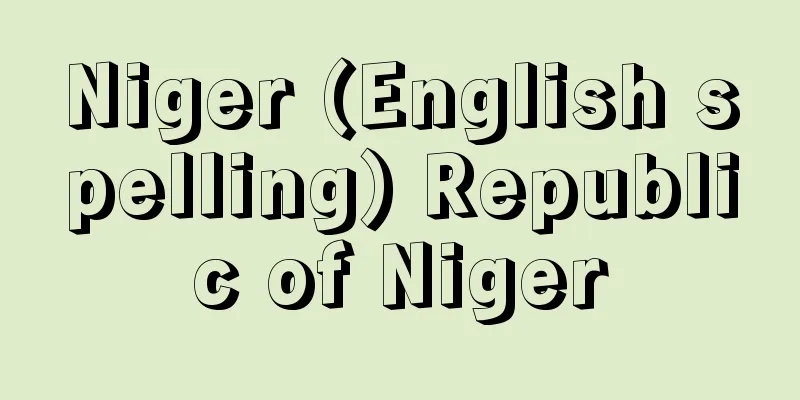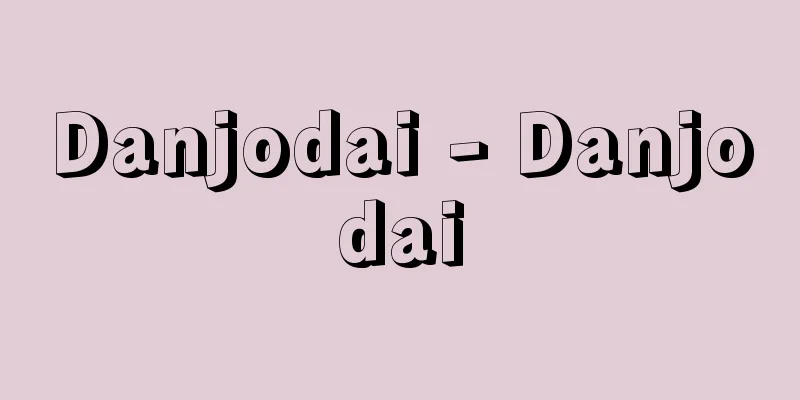Niger (English spelling) Republic of Niger

|
A typical landlocked country in the interior of West Africa. Its official name is the Republic of Niger. The country's name comes from the Niger River, which flows through the southwestern tip of the country. It borders Algeria and Libya to the north, Chad to the east, Nigeria and Benin to the south, and Mali and Burkina Faso to the west. It has an area of 1,267,000 square kilometers and a population of 13,045,000 (estimated 2006), 15,290,000 (estimated 2009). It is the second largest country in sub-Saharan Africa, but two-thirds of the country is desert, and the population is concentrated in the southern savannah region, where it rains in the summer, and the Niger River basin. It is not blessed with useful agricultural products and industrialization is delayed, and its gross national income (GNI) per capita is low at $330 (2008). In 1971, uranium development began with the cooperation of France, Japan, and other countries, and the income from this has promoted industrial development and is working to overcome poverty. The capital is Niamey on the Niger River (population 910,500; 2009 estimate). [Hiroshi Fujii] NatureThe country has a topography that is generally higher in the north and lower in the south. In the central north lies the Aïr Mountains, which are made of granite and volcanic rocks that run through them. High peaks over 1,500 meters above sea level, including the country's highest peak, Mount Gréboune (1,944 meters), line the country from north to south, forming the watershed between Lake Chad in the east and the Niger River in the west. In the northeast lies the Mangeni Plateau, which is about 1,000 meters above sea level. To the east of the Aïr Mountains lies the Tenere Desert, which is difficult to pass because of its sand dune rows, and to the west lies the Talak gravel desert, which is carved with wadis (dried valleys). Apart from the Aïr Mountains and the Mangeni Plateau, most of the country is plains at an altitude of 200 to 600 meters, with high cliffs and protruding rock masses in some places, which add variety to the monotonous topography. The northern and central regions are covered by the Saharan high pressure system all year round, with very little rain, and have a desert climate. The southern region has a steppe and savanna climate with 300 to 600 mm of rainfall in the summer, and is an agricultural region. However, this region, known as the Sahel, has unstable rainfall and is prone to drought, and desertification has been progressing recently. The average annual temperature is around 28°C, and the climate is generally hot, but in the north, it drops to around 20°C in winter and is slightly cooler. In the southern region, the sun reaches its highest altitude twice a year (the sun passes overhead twice), so it is hottest in May, when the rainy season begins, and slightly cooler in August, with another peak in October when the rainy season ends. There is a large daily temperature difference in the desert. [Hiroshi Fujii] GeographyGeographically, the country is divided into three regions: the desert regions in the north and central part, the savanna region in the south, and the Niger River coastal region in the southwest. In the desert region, there are oases at the foot of the mountains where water is available, and at the foot of the plateau, like those in Agadez and Burma. Vegetables, fruits, and dates are cultivated in the oases, and they are also bases for nomadic pastoralism. They once flourished as a stopover point on caravan routes. Rock salt has been mined since ancient times, but in recent years uranium has been discovered and it is expected that there will be deposits of other minerals. The savanna region receives rainfall in the summer, and foxtail millet, barnyard millet, sorghum (a cereal grain of the grass family), corn, cotton, and groundnuts are cultivated, and cattle and sheep are also raised. There is also fishing on Lake Chad. Cities such as Zinder, Maradi, and Tahoua are distribution centers for agricultural products and have agricultural processing factories. The Niger River coast is dotted with farming and fishing villages, producing cassava (a root crop native to South America. The roots are edible and are used to make tapioca), vegetables, and rice, and fishing is also practiced. The capital, Niamey, is the political and economic center of the country. Near the border with Benin, there is the "W National Park" (W is pronounced as Debourbe), which preserves the natural savannah, and protects lions, elephants, antelopes, and other animals. In 1996, W National Park was registered as a natural heritage site (World Natural Heritage Site) under the name "W National Park of Niger" (in 2017, the registered area was expanded to Burkina Faso and Benin, and the registered name was changed to "W Early-Pendjari Protected Areas"). In addition, the "Natural Reserves of Aïr and Ténéré" are also registered as natural heritage sites, but due to the effects of the civil war that occurred within the protected areas, it was added to the List of World Heritage in Danger in 1992. [Hiroshi Fujii] historyIt is a crossroads where the caravan route connecting the Mediterranean coast with the Gulf of Guinea and the Sudanese Corridor connecting the Niger River and Lake Chad from east to west intersect, and it has been a place of contention between neighboring countries since ancient times. The current territory of the country was created by French colonization, and various nations of various ethnic groups rose and fell in this area until the modern era. In the 18th century, the Tuareg Kingdom was established in the north, centered around Agadez, while the Hausa and Fulani kingdoms competed for dominance in the south. In the 19th century, European explorers such as Mungo Park visited the area, and France and Britain later fought over its ownership, but at the end of the 19th century, the French army occupied it, and by 1899, the border with Nigeria was established. In 1911, it was unified after being divided into three parts by military rule, and in 1922 it became part of French West Africa. After the Second World War, it became an overseas territory of the French Union, and in 1958 it became a member of the French Community, before achieving independence in 1960 under the leadership of Hamani Diori (1916-1989). Diori held power for a long time as the first president, but in 1974 a coup led by Chief of Staff Seyni Kountché (1931-1987) took place, and the Supreme Military Council, chaired by Kountché, took power. [Hiroshi Fujii] PoliticsIn a coup in 1974, the constitution was suspended, parliament was dissolved, and Chief of Staff Kounche was installed as Chairman of the Supreme Military Council. In November 1987, Chairman Kounche died, and Chief of Staff Ali Saibou (1940-2011) became Chairman. In December 1989, power was transferred to civilian rule, and Saibou became President. In the multi-party National Assembly elections in February 1993, the opposition coalition, the Alliance of Change Forces (AFC), won a majority, and in the presidential election the following month, party leader Ousmane Mahamane Ousmane (1950- ) was elected. In January 1996, the military staged a coup, and the National Salvation Committee, chaired by Colonel Ibrahim Baré Maïnassara (1949-1999), took power. The committee decided to transfer power to civilian rule by the end of the year, and held a presidential election in July of the same year, with chairman Menassara elected. In April 1999, a military coup occurred, President Menassara was assassinated, and a military government (National Reconciliation Council) chaired by Major Daouda Malam Wanké (?-2004) was established, and a new constitution was drafted. This constitution was supported by a national referendum in July. A presidential election to transfer power to civilian rule was then held in October, and Mamadou Tandja (1938-2020) of the National Movement for Social Development (MNSD) was elected. Tandja was re-elected in the presidential election in December 2004. Since 2007, the Niger Movement for Justice (MNJ), an anti-government group centered on the Tuareg people in the north, has become more active. In April 2009, the president extended his second term by three years, and announced the lifting of the ban on third terms, which was approved in a national referendum in August. The country maintains a non-aligned and neutral stance, but has close ties with France. The administration is divided into 30 regions, each with its own mayor, government office, and assembly. The judiciary has a modern three-tier court system. The military is based on selective conscription (2 years). The country has a total military strength of 5,300, with 1,500 French troops stationed there. [Hiroshi Fujii] Industry and EconomyWith an economy dependent on agriculture and livestock, the country was steadily becoming impoverished as it was a dry, landlocked country, but in 1971 uranium development began in Arlit at the western foot of the Ayr Mountains, and in January 2009 the development of the Imralen mine in the north was entrusted to the French company Areva. Aggressive economic development is on the way. 90% of the working population is engaged in agriculture and livestock farming, but the average annual rainfall is low at 515 mm (in Niamey, the capital), and is unstable, with almost no rainfall from October to April. In some areas, there is almost no rainfall throughout the year. Another problem is the low level of technology. The annual rainfall required for the agriculture and livestock industry is said to be 350 mm in farmland and 150 mm in pastoral areas. Although arable land is said to be 12% of the country's land area, in reality only 2.5% is used for farming. The country produces foxtail millet (2.78 million tons in 2007, same below), sorghum (980,000 tons), cassava (120,000 tons), white beans (280,000 tons), and rice (70,000 tons) as self-sufficiency crops, and self-sufficiency is achieved except in years of drought. Commercial crops include groundnuts (150,000 tons), cotton (1,089 tons), sugarcane (220,000 tons), and gum arabic. They practice nomadic pastoralism in the desert and steppes, and livestock farming in the savanna, raising 8.24 million cattle, 230,000 horses, 460,000 donkeys, 370,000 camels, and 22.01 million sheep and goats. They fish in the Niger River and Lake Chad, catching 30,000 tons of fish, which are dried and smoked for export to Nigeria and other countries. The country's uranium ore reserves are estimated at 2.74 million tons, and its production volume was 3,032 tons (2007), both of which are the third largest in the world. The Arlit mine is the main mine, and two mining companies are funded by the Niger government, France, Spain, Japan, and other countries. The ore is transported by dedicated roads and exported from the port of Cotonou (Benin). Other mineral resources include coal, tin, phosphate ore, and rock salt. Industry is centered on agricultural processing, including groundnut hulling and oil refining, cotton yarn, cotton textiles, clothing, flour milling, leather, and beer, as well as plastics, cement, and building materials. Industrial cities include Niamey, Maradi, and Zinder. Well-known traditional crafts include leatherwork in Zinder, goldwork in Niamey, and silverwork in Agadez. In terms of export items, uranium has replaced agricultural products, accounting for 63.2% (2007, same below), followed by gold at 12.4%, vegetables, livestock, and peanut oil. Import items include petroleum products (15.1%), automobiles, pharmaceuticals, machinery, etc. The main export partners are France (44%), Japan, Switzerland, Nigeria, and the United States, while the main import partners are France, the United States, and Côte d'Ivoire, with France accounting for a large proportion of both exports and imports. The total length of roads is 13,187 km (1987). The Arritou-Dossou-Benin uranium transport road is well developed. Two of the Trans-Saharan motorways (Agades-Zinder, Niamey-Dossou) pass through the country. Gaya is the main river port. There is an international airport in Niamey and 20 airports in the country's cities. [Hiroshi Fujii] Society and CultureIt is a multi-tribal nation due to the artificial borders drawn during the colonial period. The main tribes are broadly divided into nomads and farmers. The nomads include the Tuareg (3%) who live in the desert west of the Ayr Mountains, the Toubu who live in the desert to the east, and the Pour (Fulbe) who live throughout the country and are settled livestock farmers. The farmers include the Songhai (24%) who live in the southwest, the Hausa (54%) in the central south, and the Kanuri (11%) who live in the southeast. The majority of the population is Muslim, accounting for 85% of the population. The official language is French, but Hausa is also widely spoken, and each tribe uses their own tribal language. There is no written language other than Tamashek, spoken by the Tuareg, and there are storytellers (griots). The population growth rate is high at 3.6% (2000-2006), and the population structure by age is pyramidal, with 49.5% under the age of 15, which poses major problems in future education and employment. There is also a large amount of labor migration to the Gulf of Guinea countries. There are very few doctors and nurses, and hospitals are limited to cities, so the standard of medical care is low, but with assistance from the United Nations, measures are being taken to combat infectious and endemic diseases. Education is provided above primary school, with lycées (equivalent to junior and senior high schools in secondary education), technical schools, and normal schools, and the University of Niger is located in Niamey. School attendance is low, and the literacy rate is low at 44% for boys and 16% for girls (2007). In recent years, attempts have been made to introduce education through television broadcasting. [Hiroshi Fujii] Relations with JapanSince the development of uranium, the relationship with Japan, which is seeking nuclear fuel, has become closer. A mining company has been established with investment ratios of 31% from the Niger government, 34% from France, 25% from Japan, and 10% from Spain, and uranium is being developed. In 2006, Japan imported 1,014 tons of uranium ore. Japan has also exported automobiles, motorcycles, cotton cloth, and construction machinery. Japan has also provided aid in the construction of roads, power plants, and hospitals, and in groundwater development. Japan Overseas Cooperation Volunteers have been dispatched to Niger. [Hiroshi Fujii] "Niger Expedition" by M. Park, translated by Tetsuro Morimoto et al. (1977, Kawade Shobo Shinsha) "Niger" by P. Donnan et al., translated by Iwao Kobori (Hakusuisha, Quessais-Ju Bunko) [References] | | | | | | | | | [Supplementary material] |"> Niger flag ©Shogakukan Illustration/Shogakukan Creative "> Niger Location Map Source: Shogakukan Encyclopedia Nipponica About Encyclopedia Nipponica Information | Legend |
|
西アフリカ内陸部にある典型的な内陸国。正称はニジェール共和国République du Niger。国名は国の南西端を流れるニジェール川に由来する。北はアルジェリア、リビア、東はチャド、南はナイジェリア、ベナン、西はマリ、ブルキナ・ファソと国境を接する。面積126万7000平方キロメートル、人口1304万5000(2006推計)、1529万(2009推計)。アフリカのサハラ砂漠以南で2番目に広い国だが、国土の3分の2が砂漠で、人口は夏季に降雨のある南部のサバンナ地域とニジェール川流域に集中する。有効な農産物に恵まれず工業化も遅れ、1人当り国民総所得(GNI)は330ドル(2008)と低い。1971年にフランス、日本などの協力でウラン開発が始まり、この収入により産業振興を進め貧困からの脱却を図っている。首都はニジェール河畔のニアメ(人口91万0500。2009推計)。 [藤井宏志] 自然全体に北高南低の地形を示す。中央北部には、花崗(かこう)岩とこれを貫く火山岩からなるアイル山地があり、この国の最高峰グレブーン山(1944メートル)をはじめ標高1500メートル以上の高峰が南北に並んで、東のチャド湖と西のニジェール川との分水嶺(ぶんすいれい)になっている。北東部には標高1000メートル前後のマンゲニ高原がある。アイル山地の東には砂丘列のため通過困難なテネレ砂漠、西にはワジ(涸(か)れ谷)が刻まれたタラクの礫(れき)砂漠が広がる。アイル山地とマンゲニ高原を除けば大半は標高200~600メートルの平原で、場所によっては高い断崖(だんがい)や突出した岩塊があり、単調な地形に変化を与えている。 北部、中部は通年サハラの高気圧に覆われて雨がきわめて少なく、砂漠気候を示す。南部は夏季300ミリメートルから600ミリメートルの降雨があるステップ、サバンナ気候で、農業地帯となっている。しかしサヘルとよばれるこの地域は、降水量が不安定で干魃(かんばつ)の被害を受けやすく、最近は砂漠化が進行している。年平均気温は28℃前後で全体に暑い気候だが、北部では冬20℃近くに下がってやや涼しくなる。南部では年に二度太陽の高度が最高になる(太陽が二度頭上を通過する)ため雨期の始まる5月にもっとも暑くなり、8月にやや涼しく、雨期の終わる10月にもう一度暑さのピークがある。砂漠では気温の日較差が大きい。 [藤井宏志] 地誌地理的に、北部・中部の砂漠地域、南部のサバンナ地域、南西部のニジェール川沿岸地域の3地域に区分される。砂漠地域では水の得られる山麓(さんろく)、高原麓にアガデス、ビルマのようなオアシスがある。オアシスでは野菜、果物、ナツメヤシが栽培され、遊牧の拠点でもある。かつては隊商路の中継地として栄えた。古くから岩塩の採掘が行われたが、近年ウランが発見され他の鉱物の埋蔵も期待されている。サバンナ地域は夏季に降雨があり、アワ、ヒエ、モロコシ(ソルガム。イネ科の穀物)、トウモロコシ、綿花、ラッカセイなどが栽培され、ウシ、ヒツジの牧畜も行われる。チャド湖での漁業もある。ジンデル、マラディ、タウアなどの都市は農産物の集散地で農産加工の工場がある。ニジェール川沿岸地域には農村、漁村が散在し、キャッサバ(南米原産の根茎作物。根を食用とし、タピオカの原料となる)、野菜、米を産し漁業も行われている。首都ニアメは国の政治、経済の中心である。ベナンとの国境近くにはサバンナの自然を残した「W国立公園」(Wはドゥブルベとよむ)があり、ライオン、ゾウ、カモシカなどが保護されている。W国立公園は1996年、「ニジェールのW国立公園」として世界遺産の自然遺産(世界自然遺産)に登録された(2017年に登録地がブルキナ・ファソ、ベナンへも拡張し、登録名は「W・アーリー・ペンジャリ保護地域群」に変更された)。このほか「アイールとテネレの自然保護区群」も自然遺産に登録されているが、保護区内で起こった内戦の影響により、1992年には危機遺産リスト入りしている。 [藤井宏志] 歴史地中海岸とギニア湾岸を結ぶ隊商路と、ニジェール川とチャド湖を東西に結ぶスーダン回廊とが交わる十字路にあたり、古くから周辺各国の争奪の地であった。現在の国土の領域はフランスによる植民地化によりつくられたもので、近世までは諸民族によるさまざまな国がこの地に盛衰した。18世紀には北部でアガデスを中心にトゥアレグ王国が成立し、南部ではハウサ諸王国、フラニ諸王国が支配を競った。19世紀になってマンゴ・パークらのヨーロッパ人探検家が来訪し、その後フランスとイギリスが領有を争ったが、19世紀末フランス軍が占領し、1899年までにナイジェリアとの国境を確定した。1911年軍政上3分割されていたのを統一し、1922年フランス領西アフリカの一部となった。第二次世界大戦後フランス連合の海外領となり、1958年フランス共同体の一員となったのち、1960年ハマニ・ディオリHamani Diori(1916―1989)の指導のもとに独立を達成した。ディオリは初代大統領として長く政権の座にあったが、1974年参謀長セイニ・クンチェSeyni Kountché(1931―1987)を中心とするクーデターが起こり、クンチェを議長とする最高軍事評議会が政権を握った。 [藤井宏志] 政治1974年のクーデターで憲法を停止、議会を解散し、最高軍事評議会議長に参謀総長クンチェが就任した。1987年11月、議長クンチェの死去により参謀総長アリ・サイブAli Saibou(1940―2011)が議長となった。1989年12月、民政移管し、サイブが大統領に就任した。1993年2月の複数政党制による国民議会選挙では野党連合の変革勢力同盟(AFC)が過半数を占め、翌月の大統領選挙では党首ウスマヌMahamane Ousmane(1950― )が当選した。1996年1月国軍がクーデターを起こし、メナサーラ大佐Ibrahim Baré Maïnassara(1949―1999)を議長とする救国委員会が政権を握った。委員会は年内に民政移管を行うとし、同年7月大統領選挙を実施、議長のメナサーラが当選した。1999年4月に軍のクーデターが発生、大統領のメナサーラは暗殺され、ワンケ少佐Daouda Malam Wanké(?―2004)を議長とする軍事政権(国家和解評議会)が発足し、新憲法が起草された。この憲法は7月の国民投票で支持された。ついで民政移管のための大統領選挙が10月に実施され、発展社会国民運動(MNSD)のママドゥ・タンジャMamadou Tandja(1938―2020)が当選した。2004年12月の大統領選挙でタンジャは再選された。2007年以降北部のトゥアレグ民族を中心とする反政府勢力、正義のためのニジェール運動(MNJ)の活動が活発化している。2009年4月大統領は2期目の任期を3年延長し、3選禁止の撤廃を表明して8月の国民投票で承認を得た。非同盟中立の立場をとるがフランスとの関係が深い。行政は30地方に分かれ、その下に市、村があり、それぞれの首長、役所、議会がある。司法は近代的な三審制度をとっている。軍備は選抜徴兵制(2年)。総兵力5300人、フランス軍1500人が駐留。 [藤井宏志] 産業・経済農牧業に依存する経済で、乾燥内陸国のため貧困化の一途をたどっていたが、1971年アイル山地西麓のアルリトでウラン開発が始まり、2009年1月には北部のイムラレン鉱山開発をフランスのアレバに委託した。積極的な経済開発が展開されようとしている。 就業人口の90%が農牧業に従事しているが、年平均降水量は515ミリメートル(首都ニアメ)と少なく、しかも10~4月はほとんど降水量がないなど不安定であり、地域によっては年間を通じてほとんど降水のないところもある。また、技術水準が低いことも問題である。農畜産業に必要な年降水量は農耕地で350ミリメートル、牧畜地帯では150ミリメートルが限界とされ、可耕地は国土の12%といわれるが実際には2.5%しか農耕地になっていない。自給作物としてアワ(278万トン。2007、以下同じ)、モロコシ(98万トン)、キャッサバ(12万トン)、白インゲン(28万トン)、米(7万トン)を生産しており、干魃(かんばつ)の年以外は自給量に達している。商品作物にはラッカセイ(15万トン)、綿花(1089トン)、サトウキビ(22万トン)、アラビアゴムがある。砂漠、ステップで遊牧、サバンナで牧畜が行われ、ウシ824万頭、ウマ23万頭、ロバ46万頭、ラクダ37万頭、ヒツジ・ヤギ2201万頭が飼育されている。漁業はニジェール川、チャド湖で行われ、3万トンを漁獲し、干物、薫製にしてナイジェリアなどに輸出する。 ウラン鉱は推定埋蔵量274万トン、生産量3032トン(2007)でともに世界第3位である。アルリト鉱山が中心で、二つの採鉱会社にはニジェール政府、フランス、スペイン、日本などが出資していた。鉱石は専用道路によって運搬され、コトヌー港(ベナン)から輸出される。このほか石炭、錫(すず)、燐(りん)鉱石、岩塩などの鉱産資源がある。工業は農産加工が中心で、ラッカセイの脱殻・製油、綿糸、綿織物、衣服、製粉、皮革、ビールのほか、プラスチック、セメント、建材などもある。工業都市としてニアメ、マラディ、ジンデルがある。伝統工芸ではジンデルの革細工、ニアメの金細工、アガデスの銀細工が知られている。 輸出品目では農産物にかわりウランが63.2%(2007、以下同じ)を占め、以下金12.4%、野菜、家畜、ラッカセイ油となっている。輸入品目は石油製品(15.1%)、自動車、医薬品、機械などである。主要輸出相手国はフランス(44%)、日本、スイス、ナイジェリア、アメリカ、主要輸入相手国はフランス、アメリカ、コートジボワールで、輸出入ともフランスの占める割合が大きい。 道路総延長は1万3187キロメートル(1987)である。アルリト―ドソ―ベナンのウラン輸送道路はよく整備されている。トランス・サハラ自動車道の2本(アガデス―ジンデル、ニアメ―ドソ)が通過している。ガヤが代表的河港である。ニアメに国際空港があり、国内諸都市に20の空港がある。 [藤井宏志] 社会・文化植民地時代の人為的国境策定で複数部族国家となっている。主要部族は遊牧民と農耕民とに大別される。遊牧民にはアイル山地より西の砂漠に分布するトゥアレグ人(3%)、東の砂漠に分布するトウブー人、全域に分布し定住化して牧畜を行うプール(フルベ)人がいる。農耕民には南西部に住むソンガイ人(24%)、南部中央のハウサ人(54%)、南東部に住むカヌーリ人(11%)がいる。宗教はイスラム教徒(ムスリム)が多く人口の85%を占める。公用語はフランス語であるが、ハウサ語も広く使われ、部族内では各部族語が用いられる。トゥアレグ人のタマシェク語以外は文字がなく、語部(かたりべ)(グリオ)が存在する。 人口増加率は3.6%(2000~2006)と高く、年齢別人口構成はピラミッド型で、15歳以下が49.5%を占め、将来の教育と雇用に大きな問題を抱えている。ギニア湾岸諸国への労働移住も多い。医師、看護師ともきわめて少なく、病院も都市に限られ、医療水準は低いが、国連の援助で伝染病・風土病対策が進められつつある。教育は小学校の上にリセ(中等教育の中学・高校にあたる)、技術学校、師範学校などがあり、ニアメにはニジェール大学がある。就学率は低く、識字率は男44%、女16%と低い(2007)。近年テレビ放送による教育が試みられている。 [藤井宏志] 日本との関係ウラン開発以来、核燃料を求める日本との関係は緊密の度を増している。ニジェール政府31%、フランス34%、日本25%、スペイン10%の出資比率で鉱山会社をつくり、ウランの開発を行っている。2006年(平成18)にはウラン鉱石1014トンを日本が輸入した。日本から自動車、オートバイ、綿布、建設機械を輸出した。また援助として道路、発電所、病院の建設、地下水開発を行っている。青年海外協力隊が派遣されている。 [藤井宏志] 『M・パーク著、森本哲郎他訳『ニジェール探検記』(1977・河出書房新社)』▽『P・ドナン他著、小堀巌訳『ニジェール』(白水社・文庫クセジュ)』 [参照項目] | | | | | | | | | [補完資料] |"> ニジェールの国旗 ©Shogakukan 作図/小学館クリエイティブ"> ニジェール位置図 出典 小学館 日本大百科全書(ニッポニカ)日本大百科全書(ニッポニカ)について 情報 | 凡例 |
>>: Nishiura [Hot Spring] - Nishiura
Recommend
Abyss Dynasty - Abyss Dynasty
A Portuguese dynasty from 1383 to 1580. It was du...
Barn - Naya
1. A shed built outdoors for storing items. 2. A s...
Selection of Coins - Eliza
A law issued by the Muromachi Shogunate, feudal lo...
Third generation - Sanze
〘Noun〙① A Buddhist term. A general term for the pr...
Cruel Tales of Youth
Japanese film. Directed by Oshima Nagisa in 1960....
《God save the King(Queen)》(English) GodsavetheKing
…The oldest is thought to be the Dutch 《Wilhelmus...
Deuteron - juyoushi (English spelling) deuteron
A deuteron is a nucleus formed by the binding of ...
Tainenji Temple
This is a Soto Zen temple in Nagato City, Yamaguch...
Onion (Onion/Leek head) - Onion (English spelling)
A biennial plant of the lily family (illustration)...
Cultivator - Cultivator (English spelling)
A cultivator for field crops developed in Europe ...
Milev, Geo
Born: January 15, 1895 in Radnevo [Died] May 15, 1...
Kjeldahl, JGC (English spelling) KjeldahlJGC
...The nitrogen volume is converted to weight to ...
procercoid
…A representative example of a pseudophyllum is t...
Ema Tokimori - Ema Tokimori
...Lord of Takahara-go, Yoshiki-gun, Hida Provinc...
Periodic profit and loss calculation
Periodic profit and loss calculation is the calcul...









